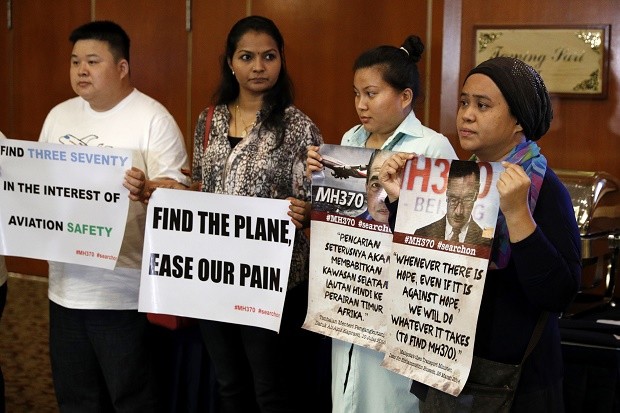Officials to decide whether to extend search for Flight 370

Family members of passengers on board the Malaysia Airlines Flight 370 that went missing on March 8, 2014 hold up a placards during a special press conference in Kuala Lumpur, Malaysia, Thursday, July 21, 2016. The oceanographer whose calculations helped an American adventurer find potential debris from Flight 370 said Thursday that the Malaysia Airlines jetliner could have crashed slightly north of the current search area. AP
KUALA LUMPUR, Malaysia — Officials from Malaysia, Australia and China will decide Friday whether to extend an underwater search for Flight 370 amid renewed appeals by families of those aboard the Malaysia Airlines jet to not give up the hunt more than two years after the plane vanished.
Malaysian Transport Minister Liow Tiong Lai has said the meeting will decide the future direction of the search, with about 10,000 square kilometers (3,900 square miles) of the designated search area still to be scanned by sonar equipment towed from ships.
So far, the search has not yielded a single clue. Officials have said the search for the Boeing 777, which so far cost 180 million Australian dollars ($135 million) —the most expensive in aviation history, will end later this year unless new credible evidence is found.
READ: Oceanographer says Flight 370 could be north of search area
Representatives from Voice 370, a group representing family members of the plane’s 239 passengers and crew, met with Australian officials in Kuala Lumpur on Thursday.
Article continues after this advertisementThey urged the governments to suspend, rather than end the search, until new funds can be raised. They also called for a wider base of funding, including from Boeing and other plane and component manufacturers.
Article continues after this advertisementThe three governments are involved because the airline was Malaysian, most of the passengers were Chinese, and the suspected crash site is off southwestern Australia.
“We are counting on world governments not to give up on us, not to give up on MH370,” said Jacquita Gonzales, whose husband Patrick Gomes was a crew member on the plane.
Australian officials still hope the plane will be spotted in the current search area, but they agreed the search should continue if new funding is provided, although this is up to the governments, said Grace Subathirai Nathan, who lost her mother, Anne Daisy.
She said that officials should consider the possibility that their calculations were wrong and that the plane may have crashed outside the current search area.
“This has been described as the most bizarre and an unprecedented air incident, and it requires unprecedented measures. They should go beyond what has been done,” she said.
Western Australia University oceanographer Charitha Pattiaratchi , whose calculations helped an American adventurer find potential debris from the missing jet, said Thursday that the plane could have crashed slightly north of the current search area.
Adventurer Blaine Gibson has handed Malaysian authorities three pieces of debris and personal belongings he found on Madagascar beaches and which he suspects came from the Boeing 777 that vanished March 8, 2014.
Pattiaratchi said the same drift modeling that Gibson relied on while looking for the debris led his team of oceanographers to suspect the plane could have gone down just north of the search area in the southern Indian Ocean.
“The best guess that we think is that it’s probably around the Broken Ridge region, which is slightly to the north of the area that they’re looking at,” Pattiaratchi said.
But he could not rule out the aircraft being within the 120,000 square kilometers (46,000 square miles) of seabed being searched southwest of Australia. Despite the drift modeling and other predictions officials have made about the plane’s possible flight path, no one has been able to explain what has become one of aviation’s biggest mysteries.
Drift modeling was not used to define the search area because no parts of Flight 370 had been found before a wing flap washed up on La Reunion island off the African coast a year ago. The search area was determined by analysis of satellite signals that the plane emitted in its final hours.
But the ATSB has previously said wreckage found on the southwestern shores of the Indian Ocean was consistent with the plane crashing in the expansive search area.
Pattiaratchi’s modeling was based on how long the first piece of confirmed Flight 370 wreckage took to reach La Reunion, and his team’s calculations of the effects of currents, wind and waves on drifting debris put the crash site just north of the current search area.
READ: Sister says don’t make missing Flight 370 pilot the fall guy